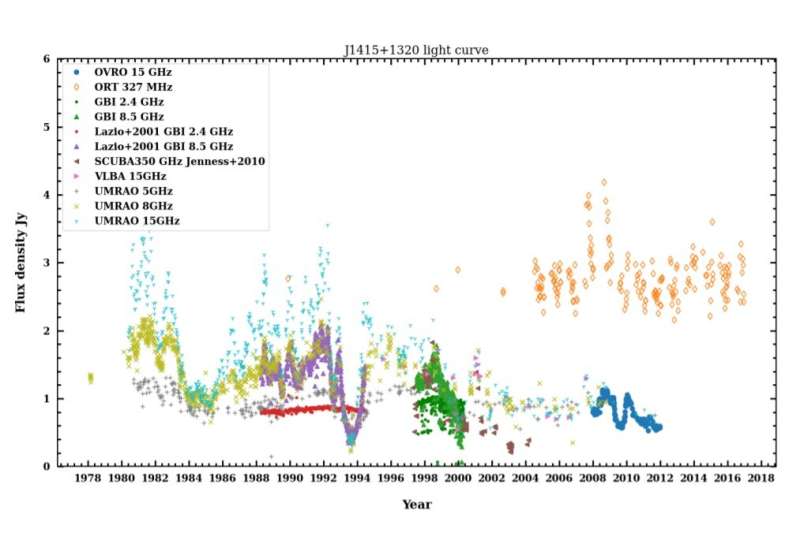October 25, 2021 report
Variability of blazar J1415+1320 investigated by researchers

Astronomers have used the Ooty Radio Telescope (ORT) to probe a blazar known as J1415+1320. Results of the study deliver essential information regarding the variability of this peculiar source. The research was detailed in a paper published October 14 on the arXiv pre-print repository.
Blazars are very compact quasars associated with supermassive black holes at the centers of active, giant elliptical galaxies. Based on their optical emission properties, astronomers divide blazars into two classes: flat-spectrum radio quasars (FSRQs) that feature prominent and broad optical emission lines, and BL Lacertae objects (BL Lacs), which do not.
In general, blazars belong to a larger group of active galaxies that host active galactic nuclei (AGN), and their characteristic features are relativistic jets pointed almost exactly toward the Earth. However, the detailed mechanisms of ejection and collimation of jets are still poorly understood, and more studies of this phenomenon are required to improve our knowledge on the subject.
At a redshift of between 0.247 and 0.5, J1415+1320 is a BL Lac exhibiting some peculiar properties. These include apparent yet rare association of the AGN with an optical spiral host, detection of a counter jet in a blazar type AGN, and its association to the class of compact symmetric objects, as well as blazar. Moreover, the source showcases strong variability in the radio light curve, which could be attributed to both relativistic beaming and gravitational lensing.
To further investigate these properties, especially the strong variability of J1415+1320, a team of astronomers led by Sravani Vaddi of the Arecibo Observatory in Puerto Rico, analyzed the data from ORT, which monitored this blazar between 1989 and 2018.
"The data for this study comes from the extensive interplanetary scintillation (IPS) database collected during the period 1989−2018 on a large number of compact radio sources of angular size less than 250 mas from the Ooty Radio Telescope (ORT), operated by the Radio Astronomy Centre, Tata Institute of Fundamental Research, India, at 327 MHz," the researchers wrote in the paper.
The ORT observations found that J1415+1320 displayed significant variability above its mean flux density of about 2.70 Jy at two epochs around 2008 and 2009. Besides these two epochs, the flux density remains constant throughout the observed period.
The variability index (VI) for J1415+1320 was about 8 percent. The astronomers noted that the average VI of sources that are found to show significant variability is at a level of 10 percent. They assume that the lower VI of this blazar may be indicating variability that is either weak or absent.
Moreover, the researchers conducted a structure function (SF) analysis of J1415+1320's variability. They found that the SF in this blazar shows a two-level structure. It rises gradually when compared to the control source, and approaches a plateau around a lag index of 10 (in 2004) and then increases around a lag index of 22.
Summing up the study, the authors of the paper write that the results are inadequate to obtain robust estimates of variability properties of J1415+1320. They believe further monitoring studies of this source at other low frequencies will be useful in order to better understand its variability.
More information: Sravani Vaddi, P.K. Manoharan, Anish Roshi, Long-term meter wavelength variability study of Blazar J1415+1320 using the Ooty Radio Telescope. arXiv:2110.07705v1 [astro-ph.GA], arxiv.org/abs/2110.07705
© 2021 Science X Network





















